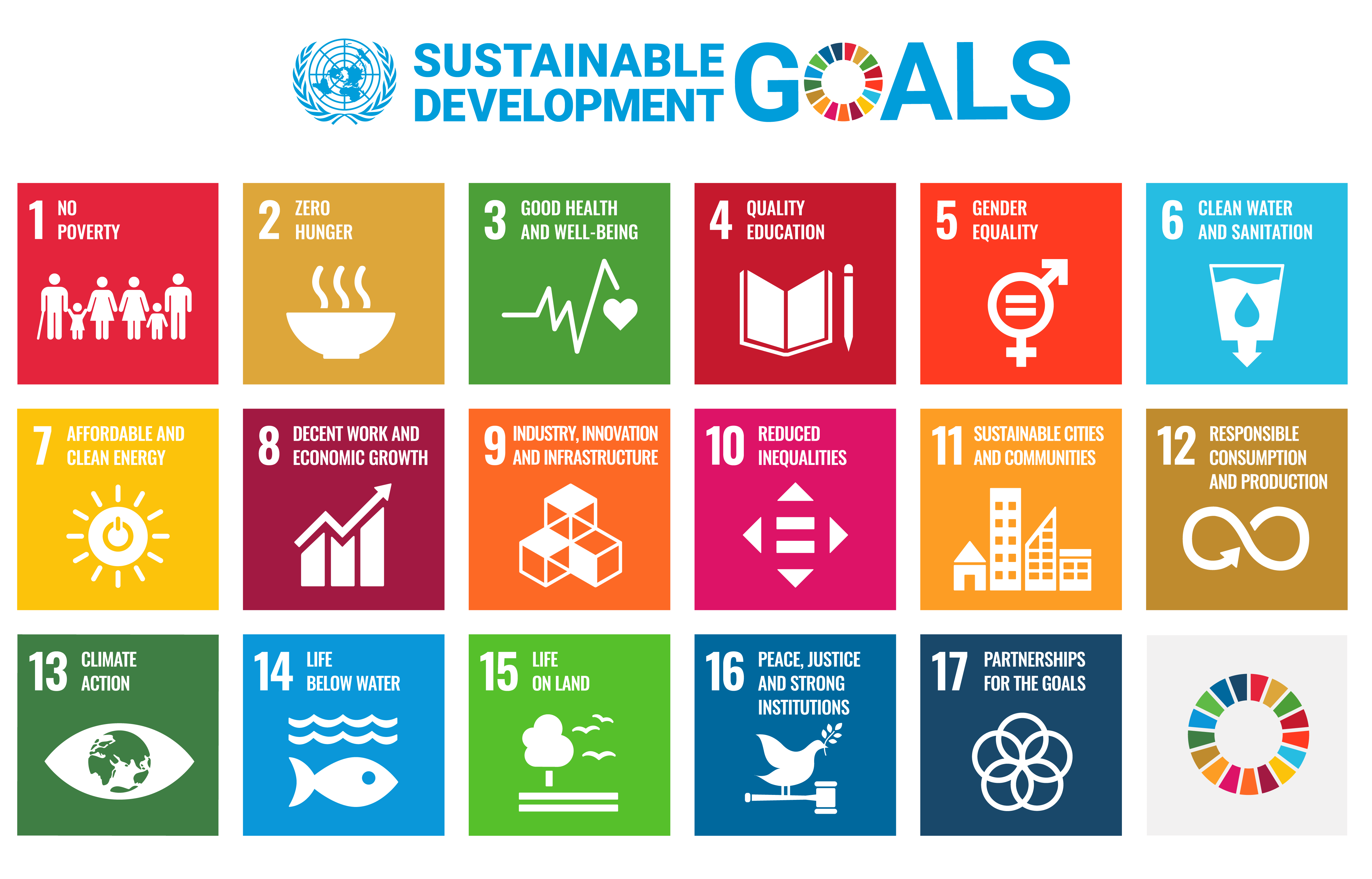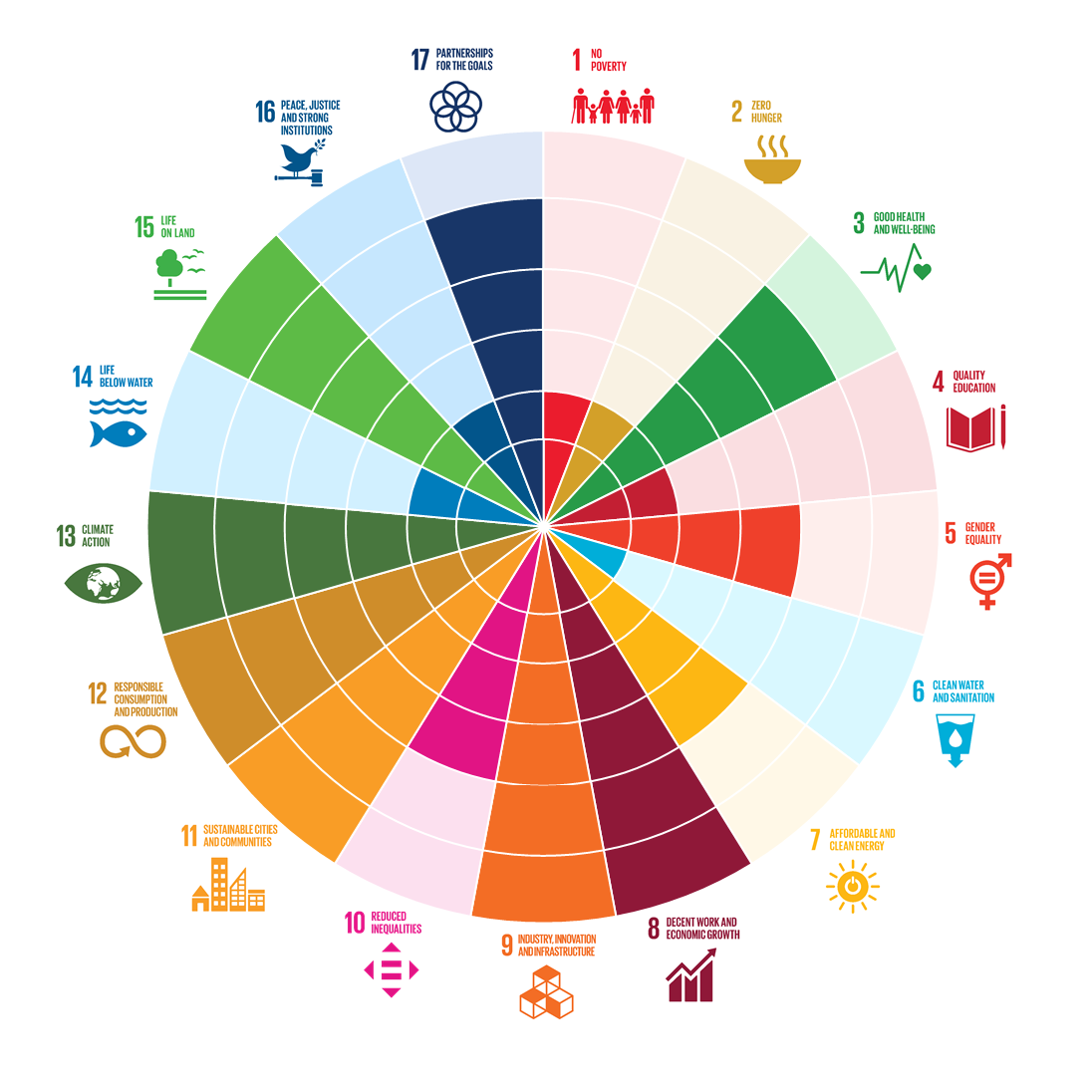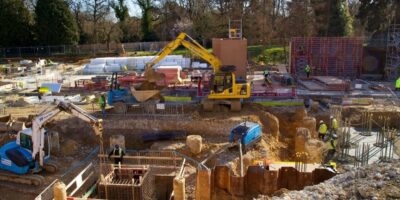The 17 Sustainable Development Goals
The 2030 Agenda for Sustainable Development, adopted by all United Nations Member States in 2015, provides a shared blueprint for peace and prosperity for people and the planet, now and into the future.

How are businesses expected to support the SDGs?
An organisation should aim to address its most material sustainability issues, which means the issues that are most relevant to its business. These issues may be risks (harmful impacts) or opportunities (areas where an organisation can make a positive contribution). Each organisation’s sustainability priorities will differ and one of the first steps to becoming a more sustainable business is identifying the key issues.
Businesses of all sizes and across all sectors have been called on to prioritise their actions around the SDGs, which means focusing on the targets that are most material to their operations. Companies should avoid aligning with targets that are ‘easy’ to do and should address those that represent the largest negative impacts or those where they have the opportunity to create the largest positive impacts.

How can the School support the SDGs?
The built environment industry is central to the delivery of policies for sustainable development through the adoption of sustainable design, procurement, construction methods and management practices associated with delivery and operation of buildings and infrastructure.
The Supply Chain Sustainability School is not directly responsible for building or maintaining assets. We promote learning, innovation and best practice to improve the sustainability skills of the supply chain to encourage a more sustainable built environment and, like all organisations, we have a role to play in delivery of the SDGs. Whilst the goals are interconnected, some are more aligned and more relevant to the School’s activities. We have used the SDGs to ‘sense check’ that the School is addressing the key impacts relevant to built environment supply chains.
Most relevant SDGs to the School
Whilst the School can arguably make a contribution to all the SDGs, the following are more central to the sector and the School’s activities here in the UK.
 Ensure healthy lives and promote well-being for all at all ages
Ensure healthy lives and promote well-being for all at all ages
A sustainable built environment can significantly contribute to socio-economic development and well-being. Our Social Value by Design guide examines this, detailing how properly designed assets can promote health and well-being for all users.
Poor air quality is reported to be responsible for 40,000 premature deaths in the UK[1]. Although the focus is mostly on industrial and transport related emissions, the impact of non-road machinery is a significant contributor. Our work on air quality in the Plant Group will help to establish and implement minimum standards for cleaner plant.
The industry is also grappling with high rates of mental illness in construction workers. Office of National Statistics figures in 2017 highlight that the risk of suicide among low-skilled male labourers, particularly those in construction, is 3.7 times higher than the male national average. Other research reveals that work-related stress, anxiety and depression has cost the industry 400,000 work-days a year and accounted for around 20% of all cases of ill health in construction over the last five years.[2]. The FIR Programme is raising awareness of health and well-being issues in the sector and the FIR toolkit provides guidance on worker well-being on construction sites and mental ill health.
[1] https://www.nhs.uk/news/heart-and-lungs/air-pollution-kills-40000-a-year-in-the-uk-says-report/
[2] https://www.raconteur.net/business-innovation/building-up-wellbeing-in-construction
 Promote sustained inclusive and stable economic growth, full and productive employment and decent work for all.
Promote sustained inclusive and stable economic growth, full and productive employment and decent work for all.
Economic growth is inextricably linked with the other SDGs. Stronger economies will afford us more opportunities to build a more resilient and sustainable world. Economic growth must be inclusive improving the well-being of all sections of society, especially the most vulnerable.
The UK built environment sector has a key role to play in delivering this goal. It employs over 3 million people (10% of our workforce) and construction output is more than £110 billion per annum which forms 7% of UK GDP.
The School’s employment, skills and ethics resources align with this goal as we address issues that can help achieve a productive workforce. We provide guidance to our members about:
- The terms under which people are employed (e.g. use of zero hours contracts, working time directives)
- Wages rates (e.g. minimum wage, living wage)
- Workforce skills development (e.g. apprenticeships, training)
- The conditions in which people work (addressed, for example, by Gangmaster regulations and the Modern Slavery Act)
- How people are treated at work (addressed by our Fairness Inclusion and Respect Programme)
Such activities help the sector attract talent from our country’s increasingly diverse talent pool.
 Build resilient infrastructure, promote inclusive and sustainable industrialisation, and foster innovation
Build resilient infrastructure, promote inclusive and sustainable industrialisation, and foster innovation
Building resilient infrastructure is central to the effective functioning of the economy and, therefore, a major driver for the delivery of many SDGs. The School brings a host of world-class resources to enhance skills, promote innovation and drive sustainable infrastructure and the built environment.
- Offsite resources help build understanding of the five elements of industrialisation – DfMA, Offsite Construction, Logistics, Onsite Assembly and Design for Maintenance.
- Our BIM resources help members understand the world of digital construction including a free online BIM assessment tool to benchmark current knowledge.
- The Lean Construction School provides learning materials and resources to help drive efficiency and ultimately support the challenging targets set out on the 2025 Construction strategy: 33% lower costs, 50% faster delivery, 50% lower emissions and 50% improvement in exports.
- Our sustainability resources provide guidance to increase resource efficiency and promote clean and environmentally sound construction practices
- The Fairness, Inclusion and Respect programme helps clients and large contractors work together and engage with their supply chains to develop a culture of Fairness, Inclusion and Respect (FIR) within their workplaces. As a sector, we need to embrace FIR to attract, recruit, train and retain the skills and talent that we need to deliver our pipeline of works.
 Make cities and human settlements inclusive, safe, resilient and sustainable
Make cities and human settlements inclusive, safe, resilient and sustainable
Today, 54% of the world’s population lives in urban areas, a proportion that is expected to increase to 66 per cent by 2050. Projections show that urbanisation combined with the overall growth of the world’s population could add another 2.5 billion people to urban populations by 2050.
It is essential that our urban spaces are attractive, healthy, flexible and functional places that people enjoy living in.
The School provides resources to increase the knowledge, skills and competence of our supply chain members to deliver more sustainable, inclusive, safe and resilient built environments. Social value can be consciously created during the design, construction and operation of built environment assets. Designers and architects play a key role here and the School’s Social Value by Design of the Built Environment’ guidance reaches out to those who influence design to help ensure social value is considered and incorporated.
 Ensure sustainable production and consumption patterns
Ensure sustainable production and consumption patterns
This goal aims to achieve the sustainable management and efficient use of natural resources and substantially reduce waste generation through prevention, reduction, recycling and reuse, by 2030. In 2014, UK construction, demolition and excavation (CDE) was responsible for 59%[1] of all UK waste. In the same year, the recovery rate for non-hazardous construction and demolition was reported to be 89.9% but the challenge to reduce waste at source remains, as does moving surplus materials up the waste hierarchy.
The sector also consumes large amounts of materials, possibly as much as 55% of annual material consumption[2].
The School provides a comprehensive suite of learning resources to help reduce waste, from simple changes on site to reduce, re-use and recycle construction waste, through to the implementation of lean construction principles that can minimise both wasted materials and wasted time. Designing out waste is also one of the key elements of lean construction and the circular economy. The School has a growing body of learning resources to promote a transition to more circular practices, encouraging resources to flow in a circular way, thereby eliminating waste wherever possible.
SDG 12 encourages companies to adopt sustainable business practices, and to integrate sustainability information into their reporting cycle. It also recognises the importance of promoting sustainable procurement practices. This is central to the School’s offering and our resources provide guidance on sustainability strategy, performance measurement and sustainable procurement for large or smaller organisations, based on best practice advice outlined in ISO 20400.
[1] Taken from DEFRA February 2018 edition of UK Statistics on Waste
[2] BREEAM Mat 6
 Take urgent action to combat climate change and its impacts
Take urgent action to combat climate change and its impacts
Responding to climate change is one of the greatest challenges of our era. With buildings (including their operation) contributing up to 50%[1] of total CO2 emissions, it is clear the built environment sector has a vital and urgent role to play. It’s also worth noting that 55% of the global industrial carbon emissions come from the manufacture and processing of five key materials: steel (25%), cement (19%), paper (4%), plastic (3%) and aluminium (3%). Of these materials, our industry is a primary consumer of cement and is responsible for consuming approximately 26% of aluminium, 50% of steel, and 25% of plastic. Climate change will affect levels of rainfall, heat and wind and frequency of storms, meaning we must adapt our building practices and construct clean, healthy, low carbon assets that are resilient to climate related hazards.
The School provides extensive learning resources at beginner, intermediate and expert level covering a wealth of related issues including climate change mitigation and adaptation, energy management and energy reduction, embodied energy, low carbon retrofit, energy reporting, carbon footprinting and carbon offsetting.
[1] BREEAM Mat 6 see: https://www.breeam.com/BREEAMUK2014SchemeDocument/content/09_material/mat06.htm
 Protect, restore and promote sustainable use of terrestrial ecosystems, sustainably manage forests, combat desertification and halt and reverse land degradation, and halt biodiversity loss
Protect, restore and promote sustainable use of terrestrial ecosystems, sustainably manage forests, combat desertification and halt and reverse land degradation, and halt biodiversity loss
The biological diversity (biodiversity) of wildlife, plants and their habitats is a vital component of healthy, well-functioning ecosystems, which in turn sustains all life on the planet. Research from the European Commission highlights that the wellbeing of every human being is ‘directly dependant on ecosystem services’. However, the current rate of global diversity loss is estimated to be 100 to 1000 times higher than the naturally occurring rates.
As a percentage, the amount of land in the UK that is ‘built on’ is very small, however urban expansion and the sector’s massive consumption of natural resources means that it has a key role to play to address SDG 15. Biodiversity is a core issue addressed by the School. We provide:
- Advice on how construction projects can move beyond a compliance approach and positively impact local wildlife in planning and development
- Learning resources relating to responsible sourcing of materials to minimise damage to the environment, and minimise depletion of resources from the point at which a material is mined or harvested in its raw state through manufacture and processing
- Learning resources on use, reuse and recycling, until its final disposal as waste with no further value
Positive School impact SDGs
The activities of the Supply Chain Sustainability School should have a positive impact on some of the targets linked to the SDGs below.
 Ensure inclusive and equitable quality education and promote lifelong learning opportunities for all
Ensure inclusive and equitable quality education and promote lifelong learning opportunities for all
In the construction sector, education and training is vital. The School offers over 2,500 resources covering a variety of issues (Sustainability, offsite, BIM, management and Lean construction) to help our Partners and supply chain members acquire the knowledge and skills needed to promote a more sustainable built environment. Our CPD accredited e-learning and workshops help support professional development across the sector. The School is paid for by our Partners, so it is free to anyone with an interest in sustainable development.
 Achieve gender equality and empower all women and girls
Achieve gender equality and empower all women and girls
Construction has historically been a male-dominated industry lacking female representation across all levels, particularly in senior management. Times are changing, and the needs and benefits of having a diverse workforce are increasingly being recognised.
Through the School’s FIR Programme, we help member organisations to build an environment that develops, enhances and retains female staff, and encourages women to enter the industry. We strive to make construction an industry that both women and men enjoy being a part of and the FIR toolkit provides a range of free resources that anyone can access and use, at any time.
 Ensure access to affordable, reliable, sustainable and modern energy for all
Ensure access to affordable, reliable, sustainable and modern energy for all
This goal requires a substantial increase in the share of renewable energy in the global energy mix and a doubling the global rate of improvement in energy efficiency. The built environment sector can play a significant role by incorporating renewable energy technology on built assets and improving the energy efficiency of building and structures. Furthermore, the construction industry is considered to be the industry that could potentially reduce its energy consumption with the lowest cost[1]
The School provides numerous learning resources to help members improve energy management, carbon and energy reduction and use of low carbon technologies.
[1] http://apppm.man.dtu.dk/index.php/Implementation_of_the_SDGs_in_the_Construction_Industry#cite_note-1
 Reduce inequality within and among countries
Reduce inequality within and among countries
Targets associated with this SDG include the need to empower and promote the social, economic and political inclusion of all, irrespective of age, sex, disability, race, ethnicity, origin, religion or economic or other status. It also aims to sustain income growth for the poorest 40% in our society. The School contributes to SDG 10 primarily through its FIR Programme. This helps Partners and members implement a culture of fairness, inclusion and respect throughout the business and supply chain to ensure equality of opportunity, and to harness the skills and talents of a diverse workforce.
Promoting FIR brings many business benefits to the companies that work to achieve it. As a sector, construction need to embrace FIR to attract, recruit, train and retain the skills and talent that it needs to deliver our pipeline of works.
Our employment and skills guidance also helps members understand the benefits of responsible employment practices, including payment of ‘real’ living wages and reaching out to disadvantaged groups within our community, such as long term unemployed, ex-offenders and women returners.
 Protect, restore and promote sustainable use of terrestrial ecosystems, sustainably manage forests, combat desertification and halt and reverse land degradation, and halt biodiversity loss
Protect, restore and promote sustainable use of terrestrial ecosystems, sustainably manage forests, combat desertification and halt and reverse land degradation, and halt biodiversity loss
The biological diversity (biodiversity) of wildlife, plants and their habitats is a vital component of healthy, well-functioning ecosystems, which in turn sustains all life on the planet. Research from the European Commission highlights that the wellbeing of every human being is ‘directly dependant on ecosystem services’. However, the current rate of global diversity loss is estimated to be 100 to 1000 times higher than the naturally occurring rates.
As a percentage, the amount of land in the UK that is ‘built on’ is very small, however urban expansion and the sector’s massive consumption of natural resources means that it has a key role to play to address SDG 15. Biodiversity is a core issue addressed by the School. We provide:
- Advice on how construction projects can move beyond a compliance approach and positively impact local wildlife in planning and development
- Learning resources relating to responsible sourcing of materials to minimise damage to the environment, and minimise depletion of resources from the point at which a material is mined or harvested in its raw state through manufacture and processing
- Learning resources on use, reuse and recycling, until its final disposal as waste with no further value
 Strengthen the means of implementation and revitalise the global partnership for sustainable development
Strengthen the means of implementation and revitalise the global partnership for sustainable development
Goal 17 calls upon global partnerships to support the achievement of the SDGs in all countries, particularly in developing countries. The scope of School activities lies within the UK, and our Partners all have a mutual interest in building the skills of the supply chain. This collaborative model enables us to promote a unified approach and strengthen the delivery of sustainable construction practices across the supply chain.


